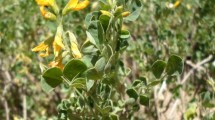Abstract
Seeds of A. bivenosa DC. Prod., A. coriacea DC., A. elata A. Cunn. Ex Benth., A. farnesiana (L.) Willd., A. nilotica Willd. ex Del., A. salicina Lindl., A. saligna (Labill.) H. Wendle., A. senegal (L.) Willd., A. tortilis (Forsk.) Hayne and A. tumida F. Muell. ex Benth. were tested for their final germination percentage (FG) in distilled water (DW) and in 25–400 mol m-3 NaCl, germination rate (1/t50, where t50 is the time to 50% of final germination in DW), Ca and K concentration (Caunt, Kunt), the leakage of these ions when soaked for 24 h in DW (CaDW, KDW) and the leakage (additional to that in DW) when soaked in 250 mol m-3 NaCl (CaNaCl, KNaCl). Linear regression revealed significant positive relationships between salinity tolerance (I50, the concentration of NaCl required to reduce final germination to 50% of the control value in DW) and FG, Rate, Caunt/Kunt and CaNaCl/KNaCl. There was also a significant negative relationship between I50 and Kunt. Multiple regression equations were developed to predict I50 from the above parameters. Equations based on (1) FG and Rate, (2) Caunt and Kunt, and (3) any of these four factors, accounted for 61, 60 and 79%, respectively, of the variation in I50. Further equations, introducing the leakage of ions into DW and NaCl and the ratios of ion concentrations monitored, improved the predictive value of the equation. The best equation, accounting for 93% of the variation was: I50 = 108 + 422 Rate − 1.32 Kunt + 16.3 CaDW − 5.4 KDW + 71.6 K/CaDW. These equations provide a screening test for salt tolerance of Acaciaseed germination based on simple and rapid laboratory chemical analyses and germination tests.
Similar content being viewed by others
References
Allan J A, Chambers A L and Stine M1994 Prospects for increasing the salt tolerance of forest trees: a review. Tree Physiol. 14, 843–853.
Catalan L, Balzarini Z, Talesnik E, Sereno R and Karlin U 1994 Effects of salinity on germination and seedling growth of Prosopis flexuosa (D.C.). For. Ecol. Manage. 63, 347–357.
Chhipa B R and Lal P 1995 Na/K ratios as the basis of salt tolerance. Aust. J. Agric. Res. 46, 533–539.
Cramer G R, Lauchli A and Polito V S 1985 Displacement of Ca by Na from the plasmalemma of root cells. Plant Physiol. 79: 207–211.
Gogate M G, Mittal R C and Pyarelal 1984 Screening through germination trials - Australian species for saline areas. Indian For. 110, 982-988.
Grattan S R and Grieve C M 1994 Mineral nutrient acquisition and response by plants grown in saline environments. In Handbook of Plant and Crop Stress. Ed. M Pessarakli. pp 203–226. Marcel Dekker Inc. New York.
Greenway H and Munns R 1980 Mechanism of salt tolerance in non-halophytes. Ann. Rev. Plant Physiol. 31, 149–190.
Huang J and Redmann R E 1995 Physiological responses of canola and wild mustard to salinity and contrasting calcium supply. J. Plant Nutri. 18, 1931–1949.
Li C C 1964 Introduction to Experimental Statistics. McGraw-Hill Book Company, New York.
Lovato M B, Martins P S and Lemos Filho J P 1994 Germination in Stylosanthes humilis population in the presence of NaCl. Aust. J. Bot. 42, 717–723.
Mason P A and Pelham J 1976 Genetic factors affecting the response of trees to mineral nutrients. In Tree Physiology and Yield Improvement. Eds MGR Cannell and FT Last. pp 437–448. Academic Press, London.
Middleton M R 1995 Data Analysis Using Microsoft Excel 5.0. Duxbury Press,Wadsworth Publishing Company, Belmont, California.
Muhammed S, Akbar M and Neue H U 1987 Effect of Na/Ca and Na/K ratios in saline culture solution on the growth and mineral nutrition of rice (Oryza sativa L.). Plant Soil 104, 57–62.
Naidoo G 1994 Growth, water and ion relations in the coastal halophytes Trilochin bulbosa and T. striata. Environ. Expl. Bot. 34, 419–426.
Nassery H 1979 Salt-induced loss of potassium from plant roots. New Phytol. 83, 32–27.
Rehman S, Harris P J C, Bourne W F and Wilkin J 1996 The effect of sodium chloride on germination and the potassium and calcium contents of Acacia seeds. Seed Sci. Technol. 25, 45–57.
Rogers M E, Noble C L, Halloran G M and Nicolas M E 1995 The effect of NaCl on the germination and early seedling growth of white clover (Trifolium repens L.) populations selected for high and low salinity tolerance. Seed Sci. Technol. 23, 277–287.
Ryan B F and Joiner B L 1994 Minitab Handbook. Duxbury Press, Wadsworth Publishing Company, Belmont, California.
Snaydon R W and Bradshaw A D 1961 Differential response to calcium within the species Festuca ovina L. New Phytol. 60, 219–234.
Simon E D 1974 Phospholipids and plant membrane permeability. New Phytol. 73, 377–420.
Rights and permissions
About this article
Cite this article
Rehman, S., Harris, P.J.C., Bourne, W.F. et al. The relationship between ions, vigour and salinity tolerance of Acacia seeds. Plant and Soil 220, 229–233 (2000). https://doi.org/10.1023/A:1004701231183
Issue Date:
DOI: https://doi.org/10.1023/A:1004701231183




